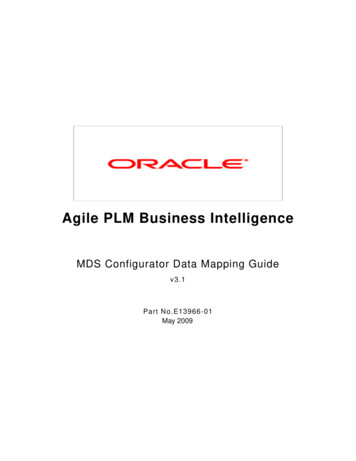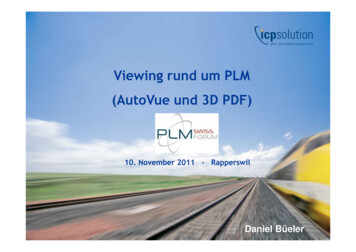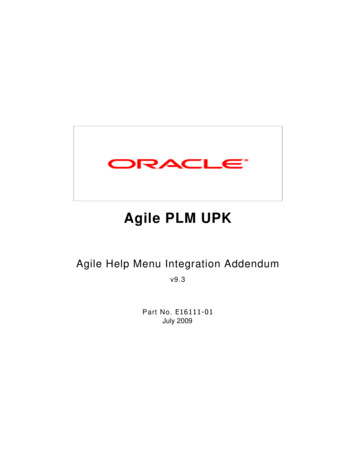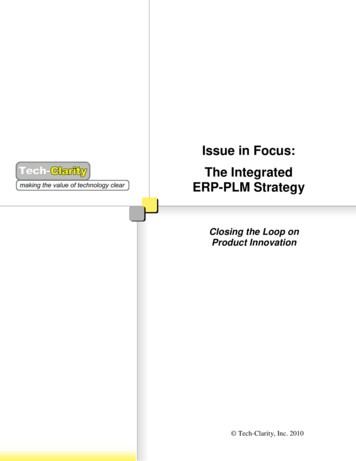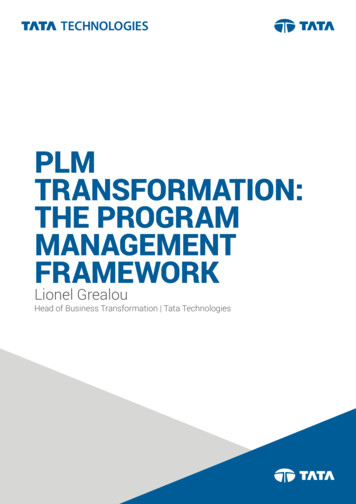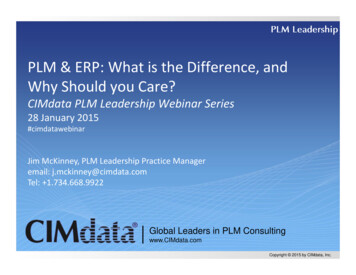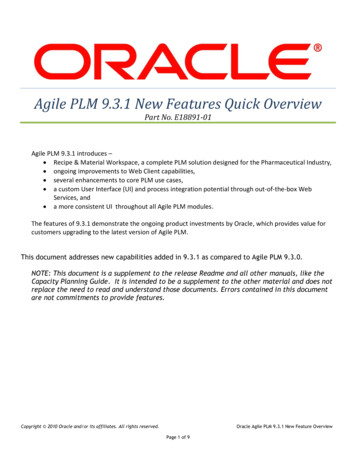
Transcription
Agile PLM 9.3.1 New Features Quick OverviewPart No. E18891-01Agile PLM 9.3.1 introduces – Recipe & Material Workspace, a complete PLM solution designed for the Pharmaceutical Industry, ongoing improvements to Web Client capabilities, several enhancements to core PLM use cases, a custom User Interface (UI) and process integration potential through out-of-the-box WebServices, and a more consistent UI throughout all Agile PLM modules.The features of 9.3.1 demonstrate the ongoing product investments by Oracle, which provides value forcustomers upgrading to the latest version of Agile PLM.This document addresses new capabilities added in 9.3.1 as compared to Agile PLM 9.3.0.NOTE: This document is a supplement to the release Readme and all other manuals, like theCapacity Planning Guide. It is intended to be a supplement to the other material and does notreplace the need to read and understand those documents. Errors contained in this documentare not commitments to provide features.Copyright 2010 Oracle and/or its affiliates. All rights reserved.Oracle Agile PLM 9.3.1 New Feature OverviewPage 1 of 9
Table of Contents1 Agile PLM 9.3.1 Resources provided by Oracle . 22 Features Added in Agile PLM 9.3.1 . 32.1 Recipe & Material Workspace, a complete solution of Agile PLM Capabilities for the Pharmaceuticalindustry . 32.2 User Experience. 42.3 Enhanced PLM Use Cases . 52.4 Platform and Web Services . 73 Additional Impact of Agile PLM 9.3.1 on existing PLM Modules . 83.1 Product Portfolio Management . 83.2 Product Governance & Compliance . 93.3 Product Cost Management . 93.4 Product Quality Management . 91Agile PLM 9.3.1 Resources provided by OracleOracle offers extensive training and documentation for customers to learn about Agile PLM 9.3.1. Below is alist of resources that can be leveraged: Software download from Oracle Edelivery: http://edelivery.oracle.com/o Note: The initial documentation package is no longer provided on Edelivery. Please go to thedocumentation page to download the latest documentation. Agile PLM Documentation Page at Oracle Technology Network ion/agile-085940.html Support through Oracle Support: https://support.oracle.com/ Samples for 9.3.1 are added to two siteso http://www.oracle.com/technology/sample code/products/agile/9.3/index.htmlo https://agileplm-projects.samplecode.oracle.com/ Oracle WIKI of Key Links: http://wiki.oracle.com/page/Agile PLM Agile PLM Solution Factory: http://www.oracle.com/goto/plmsolutionspace Agile PLM blog: http://blogs.oracle.com/PLM Twitter: http://twitter.com/agileplm Agile PLM Fusion Middleware (FMW) Best Practice pps/agile/index.html Transfer of Information Recordings available through Oracle Support: https://support.oracle.com/o These are recording of Agile PLM Product Managers discussing the major new features of AgilePLM 9.3.1. They are available to any customer with licenses and support for Agile PLM.o 9.3.1 recordings are available through Support Note 1220374.1o 9.3.0 recordings are available through Support Note 854537.1 Agile PLM Community Page available through Support or at https://communities.oracle.com/o In Support, select Community link in the top tab baro On the top left side of the page, find or select “Agile PLM Product Lifecycle Management” External Yahoo! User Groups (note: content is not managed or controlled by Oracle)o http://tech.groups.yahoo.com/group/WRAU/o http://tech.groups.yahoo.com/group/IAUG/o ght 2010 Oracle and/or its affiliates. All rights reserved.Oracle Agile PLM 9.3.1 New Feature OverviewPage 2 of 9
2Features Added in Agile PLM 9.3.1New Features added in Agile PLM 9.3.1 can be grouped into 4 categories: Recipe & Material Workspace, a PLM solution targeted at the Pharmaceutical Industry User Experience New and Enhanced PLM Use Cases Automation and Web ServicesThis section will explore the features in these main categories. The next major section will discuss additionalfeatures by module.2.1Recipe & Material Workspace, a complete solution of Agile PLM Capabilities for the PharmaceuticalindustryAgile PLM 9.3.1 introduces two modules in Recipe & Material Workspace (RMW) specifically designed toimprove productivity and traceability in the Pharmaceutical development process: Material and Equipment Management Recipe ManagementThere are significant additional launch and TOI materials available in support these robust modules. Theseadditional Agile PLM capabilities enable customers to ensure a completely traceable drug developmentprocess that can evolve into clinical supply management.When combined with existing Agile PLM enterprise capabilities, the solutions available for pharmaceuticalorganizations include the following use cases: Drug development portfolio management: Enables critical program deliverables and regulatoryrequirements to be enforced by improving drug development execution, program management,and cross-functional collaboration. Comprehensive drug development records: Structured drug development records facilitate re-useof Common Technical Documents (CTD) by capturing complex multi-dimensional data frommaterial, equipment, processes/recipes, and analytical methods in one system. Efficient clinical supply management: Delivers faster clinical trials by allowing material allocations,equipment reservations, and recipe variations during the clinical trials phase to be efficiently andeffectively managed. Faster technology transfer: Facilitates the scale-up to commercial drug production volumes bybetter enabling analysis of the drug-product value chain, including suppliers, materials, equipment,and processes. Integrated quality and risk management: Delivers an effective enterprise quality managementsolution that enables new guidelines and QbD practices to be built into the beginning of productdevelopment for faster and more efficient submissions. Integrated packaging and label management: Improves the regulatory integrity of commercialcontent by providing a global repository for all packaging components, digital assets, and marketingcollateral, all of which provide development evidence. Global product registration: Provides the content needed to support regulatory submittalrequirements. This content is used for ongoing global product proliferation. Re-use of registrationcontent can significantly improve ROI for each new product developed.Copyright 2010 Oracle and/or its affiliates. All rights reserved.Oracle Agile PLM 9.3.1 New Feature OverviewPage 3 of 9
2.2User ExperienceAgile PLM 9.3.1 continues our investment in making your users more productive in the Agile PLM Web Clientinterface by allowing more customization of user screens. We also continue to ensure support for newbrowsers. Form Customizationo Hiding fields on Title Block by Subclass: Display of Page 1 and 2 fields can be controlled at the Subclass level This adds significant customization potential by hiding non-relevant fieldscompletely on a subclass For example, if a Product ECO and an ISO ECO require different fields, theadministrator can hide fields for the different subclasseso Fully hiding fields on Title Block by Read Privilege – “No Privilege” fields can be hidden: Prior to 9.3.1, Title Block or Cover Page fields hidden using Enforce Field Level Readand Read Privilege Mask AppliedTo settings always appeared on the form with NoPrivilege or “----“. In 9.3.1, these fields do not have to appear at all depending on an additionalprivilege for “Display No Privilege Fields”. Several additional use cases are enabled, including altering the form contents for auser depending on Lifecycle Phase or Workflow Status.o Order and display of tabs can be customized: Administrators can create Tab configurations in a Web Client admin screen forClasses or Subclasses and assign the profiles to users or user groups. Tab configurations define the order of tabs, required tabs, and displayed tabs. Each time a user opens an object, their Tab configurations will be checked todetermine what to display For example, if operations users want the Attachments tab on a Part to be thesecond tab from the left, the administrator can create a new Tab configuration forParts subclass, define the Attachments tab to be second, and assign theconfiguration to a group of operations users. The next time the user opens a Part,they will see the Attachments tab in its new place.o Heading Links on Title Block: Enables easy navigation though Title Block/Cover Page screens, remaining availableat the top of the page all of the time.Streamlined Data Entry – features that allow users to complete tasks in a natural, efficient way,which helps reduce errorso Support to add data to tables through Saved / Advanced Searches: Users can leverage saved searches to add rows to tableso Support to copy object identifiers from Excel and paste into tables: Users can paste object lists from Excel into the Add box on a table Firefox users may require a setting change, which is documented in the TOIs.o Inactive List Values can be Hidden: Each user can choose to view or hide inactive list valueso Filtered Dynamic Lists: Dynamic lists in Agile PLM represent lists of objects – like Items, Changes, Users, etc.Copyright 2010 Oracle and/or its affiliates. All rights reserved.Oracle Agile PLM 9.3.1 New Feature OverviewPage 4 of 9
2.3Since Agile PLM 9.0, these lists have been available to associate to List or MultiListattributes on Page 1, Page 2, or Page 3 of Agile objectsMany customers have wanted to subdivide these lists, whether by Subclass or othermatching criteria on the relevant objectsIn 9.3.1, all Dynamic Lists have a Criteria property which defines a filter for use onthe list when being displayed in the UI, for example “All Resistors” versus “All Items”Administrators can create new Dynamic Lists with associated Criteria as needed tosupport customer business processesPlease review the documentation available in the Agile PLM Administrator Guide aswell as the TOI for PLM administrators, which reviews this new feature. Note thatthis feature is not related lists, or altering the content of one list based on theselections made in a different list on the same page.Enhanced PLM Use CasesThese features are primarily focused on the core Product Record, including the modules Product Collaborationwith Document Management and Engineering Collaboration Your Workflow Your Wayo Configurable Approval Password requirement: Each Review or Release workflow status can be configured to collect a password ornot for approve and reject actions For example, a review status called could be configured to not require a passwordfor “Approve” but require one for “Reject”. When the user approves, they are notprompted for a password. If they reject, they are prompted for a password.o Allow a Workflow to contain multiple Hold and Cancel statuses: The specific reasons for Hold status can now be configured in a workflow. Specific “Manual Valid Next Status” control can be used to allow precise statusmovement from a Hold status. If “Collect Test Results” is configured as a new Hold status in a workflow, theadministrator can set Manual Valid Next Status to allow movement to “Collect TestResults” from a Pre-CCB Status, and only return to a Pre-CCB status from “CollectTest Results”. This makes the new Hold status a well defined step in the workflowthat can only be entered from Pre-CCB and can only return to Pre-CCB. There aremany potential variations and usage of this capability.o Next Status button can move to any valid status: Users with the correct privilege can move a Routable Object to any valid statuswithout having to go to the Workflow tab.o Populate default change analyst in Workflow even if the user can't edit it: Agile workflow criteria become more capable of forcing a specific Change Analyst atthe Pending status.o Do not validate entry criteria against Completed or Canceled changes when modifying anItem: When a customer is using Workflow Entry Criteria, historically the entry criteriarestrictions apply at all times in the lifecycle of the Items and Changes. If an entry criteria for a workflow is based on Product Line and an Item is associatedwith a Change leveraging that workflow, then the Product line for an Item couldCopyright 2010 Oracle and/or its affiliates. All rights reserved.Oracle Agile PLM 9.3.1 New Feature OverviewPage 5 of 9
never be changed unless the administrator altered SmartRules or changed theworkflow Entry Criteria. If a user tries to change the Product Line, Agile PLM throwsan error message that informs alteration violates Workflow Entry Criteria. As of 9.3.1, violations of Workflow Entry Criteria for Changes that have reached theirComplete or Cancel status will no longer be evaluated. This should enable morenatural attribute modification for customers using Workflow Entry Criteria.o Visual indicator for active (Released) Stop Ships and Deviations in tables: Prior to 9.3.1, the Item Changes tab display a red square when there are ReleasedStop Ships or Deviations against the Item. This replaces the grey circle that indicatesa non-Released Change against the Item. Tables including the Item, like SearchResults, BOM, or Affected Items, never displayed the red square and did not displaya grey circle for released Stop Ships or Deviations. In 9.3.1, table results will display a red square when there is a released Stop Ship orDeviation. This provides more visibility to a user about Items that may have severeissues when reviewing Search results or other tables of Items like BOMs andAffected Items.Dynamic publishing of product informationo New web services introduced for getting object schema and data: Web Services ‘loadXMLSchema’ and ‘loadXMLData’ have been addedo Enables auto-refresh Product Datasheets, parts list, service manuals with PLM data usingsimple process extensions: Several samples are being published which describe how to leverage these newserviceso Potential integration with popular authoring tools (like Microsoft Word using BI Publisher): The completeness of the Schema and Data services allow customers to accuratelygenerate document templates and then combine the template with Agile PLMObject Data to create a finished document. Other tools, like Adobe Framemaker, which also can use XML Schema information tocreate a Template and then combine later with actual Data XML, can also be usedVariant Managemento Variant management adds capability to Product Collaboration which enables customers tomanage Model–Option BOMs to define the potential variations which need to be chosen ina Sales Configuratoro This capability enables organizations to define the potential BOMs in the designorganization using a Change Control process and feed the results into a Sales Configuratoro Model and Option class subtypes introduced which enables additional UI and Business Logico The Agile configuration screens incorporate editing of multiple Instances and usabilityimprovements, including better error messageso Added an Instances tab to link Model–Option BOM to Instances and other navigationenhancementso Oracle Configurator Integration through the Design to Release Oracle ApplicationIntegration Architecture (AIA) Process Integration Pack (PIP) .Improved Basic Design Managemento Structured display, Improved visibility of key attributes, design exporto Extend attribute visibility to new tabso Separate “Copy Files to Rev” SmartRules for Designs and File FoldersCopyright 2010 Oracle and/or its affiliates. All rights reserved.Oracle Agile PLM 9.3.1 New Feature OverviewPage 6 of 9
2.4o Design Where Used – checkbox for “Display all versions”o Add Revision field to Design Version selectoro Support Navigator with Design structureso Structured Get for Designso Open button is available on Attachments tab.Design Change Managemento Workflow Routings links go to proper versiono Searches based on routing slip status return proper resultso New “Approval Status” attribute gives overall routing slip statuso New “Item Change Status” attribute supports better linking to Item change process.Platform and Web Services Key Platform Certification Changeso Application Server: Updated WebLogic Version – 11gR1 (10.3.2) Same iAS version - 10gR3 (10.1.3.4)o Database: Continued support for 10gR2 (10.2.0.4 ), 11gR1 (11.1.0.6 ), and 11gR2 (11.2.0.1 )(RAC and standalone)o Browser: Continued support for Firefox 2, 3, and 3.5 on Windows and Solaris Continued support for Safari 3 and 4 on Mac Continued support for Internet Explorer 7 and 8 Note that the new RMW modules are only supported on IEo Server Operating System: Add support for SuSE Linux 9 & 10 (SP3 ), IBM AIX 6.1 Continued support for Windows Server 2003 SP3 & 2008 SP1, Solaris 9 (SPARC),Solaris 10 (SPARC and x86), Oracle Enterprise Linux 4 & 5, Red Hat Enterprise Linux 4& 5, IBM AIX 5.3, HP-UX 11.31o AutoVue for Agile: Continued support for Oracle AutoVue Electro-Mechanical Professional for Agile(20.0)o Server Virtualization: Continued support for Oracle VM 2.1.2 with OEL 4 & 5 and Windows Server 2003SP3Note: Review the Oracle Agile PLM 9.3.1 Capacity Planning Guide for the official, detailedplatform certification matrix. Any errors in the list above do not override the official intendedsoftware support.Add Excel 2007 support for Import and ExportAdd LDAP Server support for Oracle Internet Directory (OID) 10g (10.1.4.0)Add Single Sign On (SSO) support for Oracle Access Manager (OAM) 10g (10.1.4.0)64-bit JVM Support for more Application Server memory (AIX, Windows, Linux)o This enables customers to run their Application Server with more than 2 GB of memoryWeb Serviceso More complete feature coverage for web services (Portal Frontend): Includes Folders, Inbox, Notification, Reports, Advanced SearchCopyright 2010 Oracle and/or its affiliates. All rights reserved.Oracle Agile PLM 9.3.1 New Feature OverviewPage 7 of 9
3o New Web Services for Document Publishingo Additional Tables Support: Tables in the Product Cost Management (PCM) solution Tables in the Product Governance and Compliance (PG&C) solution Tables in the Product Portfolio Management (PPM) solutionImprovements to Export and Search Performanceo Control maximum number of records to process when running a search: This typically applies when a user can only discover a limited set of objects andattempts to run a broad search In prior versions, the application filtered through all the objects in the system untilfinding the limited number of objects they could discover With 9.3.1, the system limits the number of objects being reviewed to betterprotect the overall application servero Better memory management in Export: Export limits its memory use when processing very large Export setso More limits on number of objects being Exported: The system limits users on how many objects they can exportImproved Security and IP Protectiono Force Users to change password: When an administrator changes a user password, the user optionally be forced tochoose a new password on the next logino Control Password expiry duration, Enforce strong passwords: Allow the administrator to choose additional password “strength” settingso More control over administrative privileges: The majority of capabilities in PLM Administrator are now offered as AppliedTovalues on Administrator privilege masks. This allows administrative rights to becarefully assigned to different users by setting up the correct Administrator privilegemasks. This does not address more specific administrative requests, like assigning users tomanage specific Lists in the Lists node. Administrator access remains at the nodeand major functionality level.o Supplier authentication against LDAP: Restricted Supplier Users can now be authenticated against LDAPo New export privilege to prevent export of attachments: The Export privilege has a new applied to setting to control whether users canexport attachments when exporting AXML and PDX.Additional Impact of Agile PLM 9.3.1 on existing PLM ModulesThis section lists new features in specific PLM solutions.3.1Product Portfolio Management Fine-grain duration of Activities (minutes or seconds)Additional Multi-List fields available for DashboardNew Projects Filtered Dynamic ListCopyright 2010 Oracle and/or its affiliates. All rights reserved.Oracle Agile PLM 9.3.1 New Feature OverviewPage 8 of 9
3.2Product Governance & Compliance 3.3Import Bill of Substances into a Declaration via Microsoft ExcelAbility to use transformation files when importing compositionsProduct Cost Management 3.4Improved Web Services CoverageComprehensive set of actions on Analysis tabFilter, sort on multiple columns to quickly get to the right dataMulti-column filtering to better track RFQ responsesConfigurable Cost rollups via ExcelPrice Models:o Web Services support for exporting data (BOM, AML, Responses etc) from Sourcing Projecto Users can export PCM data into a Spreadsheet, apply their own Price Models, recalculatethe costs using their own formula and data from external sources and import therecalculated cost back into PCM using SDKo Price Models Sample available for Excel through samples portalProduct Quality Management Extensive form customization options by hiding fields:o With the new features to hide fields by subclass and by read privilege, forms for PQMsubclasses can now be completely configured for the targeted userso User training for processes no longer has to include explanation of which fields are notneeded for the current processCopyright 2010, Oracle and/or its affiliates. All Rights Reserved.This document is provided for information purposes only, and the contents hereof are subjected to change without notice. Thisdocument is not warranted to be error-free, nor is it subjected to any other warranties or conditions, whether expressed orally orimplied in law, including implied warranties and conditions of merchantability or fitness for a particular purpose. We specificallydisclaim any liability with respect to this document; and no contractual obligations are formed either directly or indirectly by thisdocument. This document may not be reproduced or transmitted in any form or by any means, electronic or mechanical, for anypurpose without prior written permission from Oracle.Copyright 2010 Oracle and/or its affiliates. All rights reserved.Oracle Agile PLM 9.3.1 New Feature OverviewPage 9 of 9
1 Agile PLM 9.3.1 Resources provided by Oracle Oracle offers extensive training and documentation for customers to learn about Agile PLM 9.3.1. Below is a list of resources that can be leveraged: . Oracle Agile PLM 9.3.1 New Feature Overview Page 5 of 9 Since Agile PLM 9.0, these lists have been available to associate to List or MultiList .

